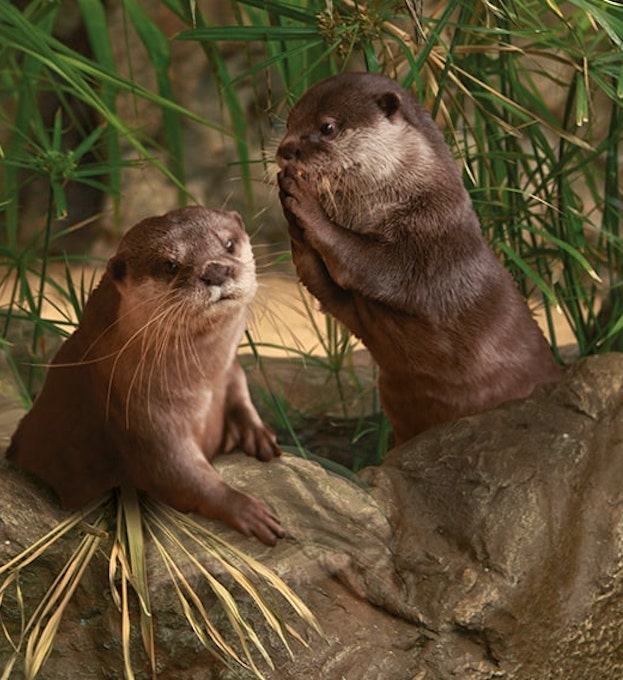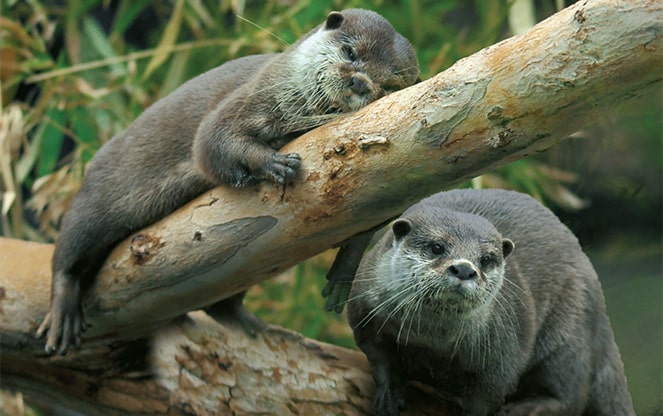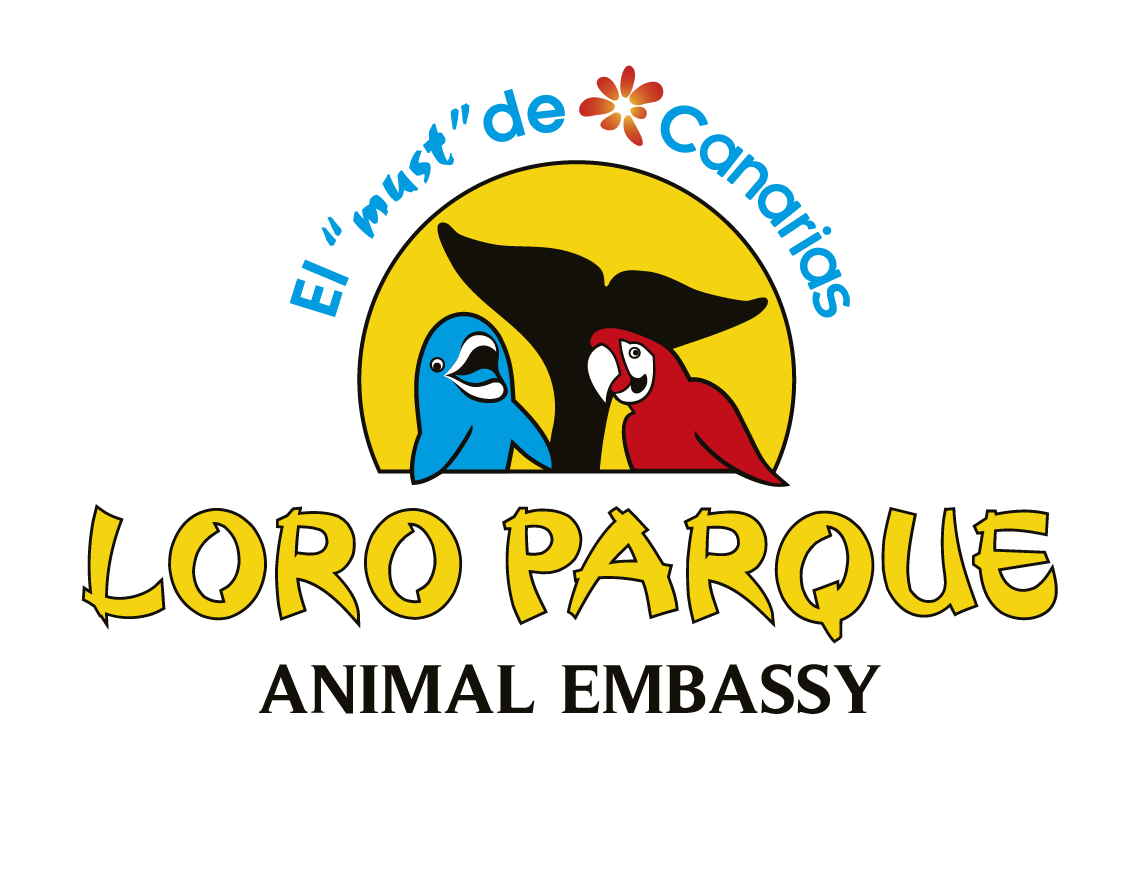Otters are one of the most fascinating mammals of the aquatic world. From rivers and lakes to coastal areas, these playful animals play a crucial role in maintaining balance in aquatic ecosystems.
At Loro Parque, you can discover everything about these playful creatures that never fail to charm both adults and children alike. Here you will learn what otters are like, their habitat, diet, reproduction, and the different types of otter species that exist.
What are otters?
Otters are semi-aquatic mammals of the mustelid family. They are elegant, wild and extraordinarily agile in water. Their sociable nature and playfulness make them instantly likeable. Just look at the reaction of our visitors when they see them for the first time at Loro Parque.

How do otters behave?
If you really want to know what otters are like, the best way is to visit Loro Parque and meet them in person. Until then, here are some key features:
- Otters are related to weasels (Mustelidae), but they are the only members of the family fully adapted to swimming.
- They vary greatly in size. South American species can reach 1.7 m, while some Asian species hardly grow beyond 45–60 cm.
- They are carnivores, with teeth adapted for crushing shells and bones. Fish form the main part of their diet, complemented with crabs and shellfish. Otters need to be fed with high frequency; this is why they can spend more than 5 hours hunting per day.
- Otters live almost everywhere in the world except Australia, Antarctica, and waterless regions.
- They require a high-calorie diet. For example, the sea otter must eat 20–30% of its body weight daily to maintain its body temperature.
- Sea otters have the thickest fur in the animal kingdom, using it as insulation since they lack blubber. Other otter species possess two coats, a dense underlayer and a waterproof top layer.
- Extremely social and playful, otters are curious about everything around them.

Types of otters around the world
There are 13 recognised species of otter worldwide, each with unique traits from the shy river otter to the impressive sea otter.
1. African clawless otter (Aonyx capensis)
They are found in southern and central Africa and are characterised by lacking claws on their toes and by the white markings on their cheeks. They live in freshwater and can be seen foraging for crustaceans, their primary food source. They are listed as near threatened according to the IUCN.
2. Congo clawless otter (Aonyx congicus)
It lives in central and west Africa, in tropical forests and swamps. Some authors consider it a subspecies of the African otter rather than a separate species. Like the African otter, it has no claws. It is one of the least known otter species. According to the IUCN, it is classified as near threatened.
3. Asian small-clawed otter (Aonyx cinereus)
Also known as the Asian river otter. It is the smallest otter species and is distinguished by its shorter claws. They are found in freshwater in South and Southeast Asia and are well adapted to habitats such as long rivers or mangroves. Their conservation status is Vulnerable according to the IUCN.
4. Sea otter (Enhydra lutris)
The spectacular sea otter lives in saltwater very close to the coasts of the North Pacific. With incredibly thick fur, the densest of any mammal, sea otters are well protected against the freezing waters where they dive daily in search of food such as sea urchins, molluscs, and crustaceans. This behaviour is mainly to obtain the nutrition they require.They exhibit this behaviour mainly to obtain the nutrition they require. Currently, they are classified as endangered according to the IUCN.
5. Eurasian otter (Lutra lutra)
A type of otter that is one of the largest of the species and the only one with a Eurasian distribution. It has a longer head and body and shorter legs that allow it to swim faster. It differs from the rest of the otters by having a distinctive white patch on its throat.
Its diet is varied, including fish, crustaceans, amphibians, and even small reptiles and birds. It is listed as near threatened by the IUCN.
6. Hairy-nosed otter (Lutra sumatrana)
It was once thought that this species had become extinct, but relatively recently, small populations were discovered in Thailand, Vietnam, Indonesia, and Malaysia. It is the least known of all otters, inhabiting Asia, and is extremely difficult to find. Its most distinctive feature is that it has a nose covered with hair, and individuals are hard to tell apart, since their identification must be done through a thorough and detailed analysis of the nose.
7. Giant otter (Pteronura brasiliensis)
It is found in the Amazon and is the largest and heaviest of all otter species, instantly recognisable by its flat tail and whitish markings on its neck. It is also one of the most social species, living in groups of up to 8 individuals. Although generally peaceful, aggressive encounters have been observed between different groups.
They are also very noisy, especially when alarmed, and their range extends across northern South America.
8. North American river otter (Lontra canadensis)
Native to North America, their double coat repels water and protects them from the cold. They are equally skilled in and out of water, and their favourite food is fish.
They are a generalist species, capable of living in almost any freshwater system (rivers, estuaries) and even marine environments, as long as sufficient suitable food is available.
As a consequence of water pollution, poaching, and habitat degradation, their populations decreased considerably in the past. Fortunately, thanks to conservation efforts, they have made a recovery and are currently listed as Least Concern by the IUCN.
9. Neotropical otter (Lontra longicaudis)
These otters have sharp, strong claws, but their most distinctive feature is their long tail (hence their name). They are often found in rivers and mountain streams.
They can be both diurnal and nocturnal, and their main diet consists of fish and crustaceans, although they also eat small mammals, reptiles, birds, and insects. They are classified as near threatened according to the IUCN.
10. Marine otter (Lontra felina)
The smallest of the American otters and the smallest marine mammal in the world. Alongside the sea otter, it is the only other mustelid species to live exclusively in marine environments (the Pacific coastline of South America).
Unlike most otters, this is a monogamous species: they mate for life. Their fur is brown and dense all over their body, except on the feet. Their diet is based on small animals that they catch by diving down to the seabed close to the coast. It is classified as endangered by the IUCN.
11. Southern river otter (Lontra provocax)
As its name suggests, this otter inhabits lakes and rocky coastal areas of Chile and southern Argentina, and has the smallest distribution range of all otters.
Its population is highly fragmented, mainly due to illegal hunting and habitat destruction. These pressures have led it to be classified as endangered by the IUCN.
12. Smooth-coated otter (Lutrogale perspicillata)
Native to Asia, inhabiting forests, rivers, and lakes. Its coat is smoother and shorter, adapted to living both in water and on land. It is capable of travelling hundreds of kilometres in search of a more suitable habitat.
This species is predominantly nocturnal. It is classified as vulnerable by the IUCN, mainly due to illegal hunting for its smooth, beautiful fur.
13. Spotted-necked otter (Hydrictis maculicollis)
Like the Eurasian otter, the spotted-necked otter has distinctive white markings around its neck. It has webbed feet and relatively small whiskers.
Highly intelligent, it prefers clear waters where food sources are easier to find. Remarkably, these otters are able to use stones to open their prey. They are distributed mainly in central Africa. The species is listed as near threatened by the IUCN.
More information on otter species can be found at the IUCN Specialist Group.

Where do otters live?
The habitat of otters depends on the species, but all are bound to water:
- Rivers: their main home, offering shelter and abundant food.
- Lakes: excellent for fishing and swimming.
- Coastal zones: where fresh and salt water meet.
- Seas: marine otters are strong divers and swimmers.
- Wetlands and marshes: adapted to shallow, swampy landscapes.
Threats to otters and conservation efforts
Sadly, otters face multiple threats: loss of habitat due to wetland destruction, water pollution, and illegal hunting for their prized pelts. These factors have caused severe population decline in many regions.
At Loro Parque and the Loro Parque Fundación, we have one clear mission: to raise awareness and promote conservation, sharing valuable insights about otters and their habitats with every visitor.
Visit Loro Parque to discover these extraordinary animals up close, learn more about their role in nature, and support the global mission to protect otters.
Be part of this important conservation effort o we invite you to join our mission











